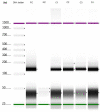Retrospective detection of asymptomatic monkeypox virus infections among male sexual health clinic attendees in Belgium
- PMID: 35961373
- PMCID: PMC9671802
- DOI: 10.1038/s41591-022-02004-w
Retrospective detection of asymptomatic monkeypox virus infections among male sexual health clinic attendees in Belgium
Abstract
The magnitude of the 2022 multi-country monkeypox virus (MPXV) outbreak has surpassed any preceding outbreak. It is unclear whether asymptomatic or otherwise undiagnosed infections are fuelling this epidemic. In this study, we aimed to assess whether undiagnosed infections occurred among men attending a Belgian sexual health clinic in May 2022. We retrospectively screened 224 samples collected for gonorrhea and chlamydia testing using an MPXV PCR assay and identified MPXV-DNA-positive samples from four men. At the time of sampling, one man had a painful rash, and three men had reported no symptoms. Upon clinical examination 21-37 days later, these three men were free of clinical signs, and they reported not having experienced any symptoms. Serology confirmed MPXV exposure in all three men, and MPXV was cultured from two cases. These findings show that certain cases of monkeypox remain undiagnosed and suggest that testing and quarantining of individuals reporting symptoms may not suffice to contain the outbreak.
© 2022. The Author(s).
Conflict of interest statement
The authors declare no competing interests.
Figures




Comment in
-
Human monkeypox outbreak 2022 and asymptomatic human reservoirs: Challenges and opportunities - Correspondence.Int J Surg. 2022 Sep;105:106849. doi: 10.1016/j.ijsu.2022.106849. Epub 2022 Aug 23. Int J Surg. 2022. PMID: 36007810 No abstract available.
-
What is fuelling the monkeypox outbreak?Nat Rev Urol. 2022 Oct;19(10):578. doi: 10.1038/s41585-022-00658-2. Nat Rev Urol. 2022. PMID: 36097209 No abstract available.
References
Publication types
MeSH terms
LinkOut - more resources
Full Text Sources
Medical

